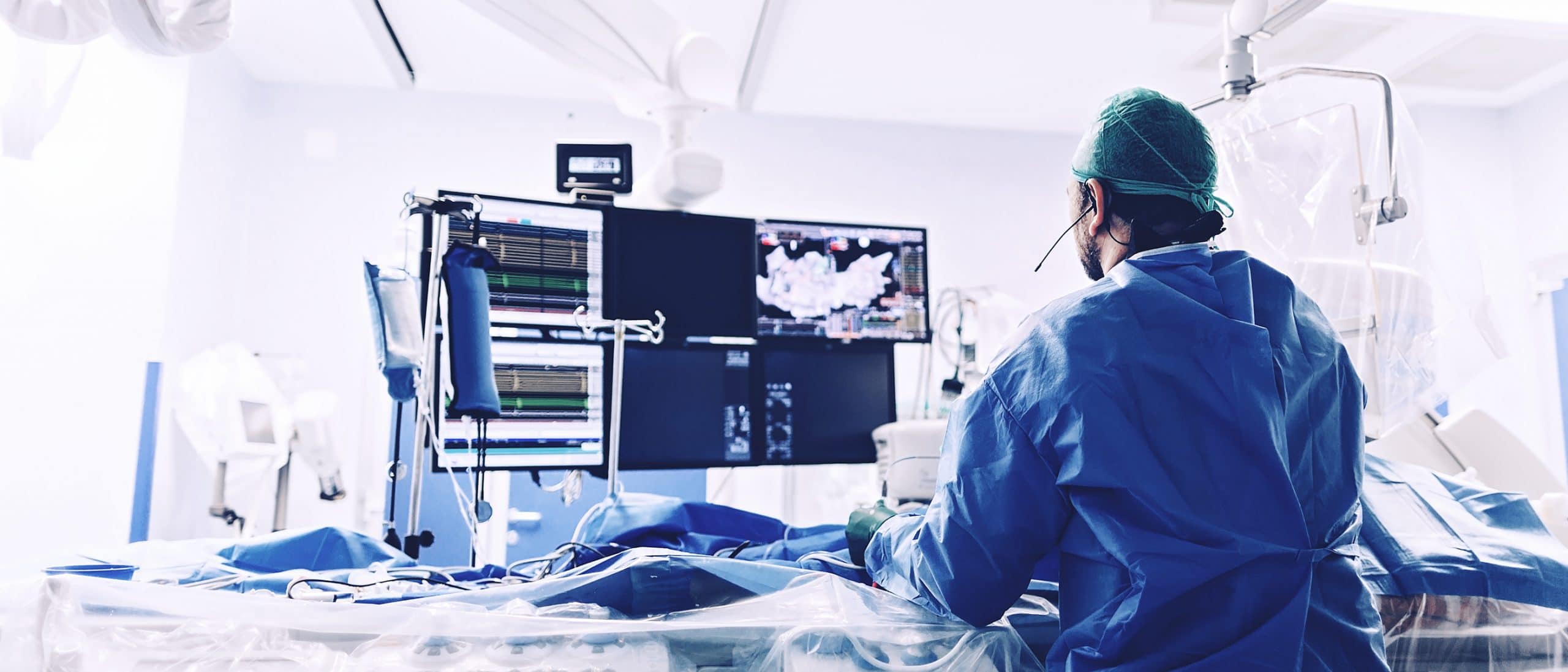Radiofrequency Ablation
Radiofrequency ablation for lung cancer is a form of minimally invasive treatment given to some patients who can’t undergo surgery.

What Is Radiofrequency Ablation Surgery?
Radiofrequency ablation is a form of minimally invasive lung cancer treatment that can be done in outpatient settings and requires little recovery time. One of every five patients with removable non-small cell lung cancer (NSCLC) tumors is unable to undergo surgery. In these cases, radiofrequency ablation (RFA) is considered the best option if tumors are closer to the outer edges of the lungs and further from the windpipe. The procedure uses a thin needle to pierce the tumor and deliver an electric current to kill cancer cells.
RFA may be used to either treat tumors or as palliative care to ease painful symptoms of lung cancer. The radiofrequency used is a high-energy radio wave capable of heating cancerous tissues to over 140°F (60°C). Using an imaging scan to guide the needle, cancer cells are killed with heat while surrounding tissues are relatively unharmed.
The short-term results of RFA are generally successful, with tumors effectively burned or shrunk directly following treatment. However, RFA may not be as effective when tumors are centrally located or near vital organs, airways, and blood vessels. In the long-term, RFA’s effectiveness in curing lung tumors is not fully known and requires further study. Yet, some international studies of the long-term effectiveness of radiofrequency ablation techniques showed an average tumor recurrence rate of about 25 months. Overall, the survival rate among lung cancer patients was about 33 months, and 41 months for patients with NSCLC.
Undergoing Radiofrequency Ablation
Typically, radiofrequency ablation procedures are administered in an outpatient setting and patients are able to return home after the anesthesia wears off. As such, when preparing for your RFA procedure, your doctor may ask you not to eat anything starting the midnight before as well as tell you which medications are okay to take. Also, you may be required to designate someone to take you home once you are released.
An RFA procedure begins with the patient on the procedure table with monitors tracking his or her heart rate, blood pressure, and oxygen levels. Anesthesia is given via intravenous (IV) line and locally where the needle is inserted. Next, a needle containing an electrode is inserted into the skin at the site of the tumor being treated. This needle delivers steady doses of electrical heat to the tumor until it dies but does little to affect the cells surrounding it.
Throughout the procedure, doctors employ imaging scans (usually a CT scan, though ultrasounds and MRIs are used at some locations) to monitor the placement of the needle and the effects of treatment. Other equipment used in the procedure includes an electrical generator and grounding pads to surround the electrode.
After surgery, the patient is moved to a recovery room until they wake up from anesthesia. Generally, recovery time is short, and patients are allowed to return home the same day. In some cases, however, patients need to be admitted overnight for observation to manage complications.

Side Effects and Complications
Compared to other cancer therapies like chemotherapy and radiation, radiofrequency ablation has fewer and less severe side effects and complications following treatment. (Although HIPEC treatment is a type of chemotherapy with fewer side-effects) While RFA is considered a safer form of cancer therapy, all types of surgery carry some level of risk. In one study of RFA, less than 25 percent of patients experienced any complications from surgery.
Common RFA complications include:
- Bleeding into lung
- Infection
- Partially collapsed lung
- Soreness or pain at the injection site
- Tiredness or feeling weak
Most post-operation side effects (such as soreness where the needle was inserted) can be treated with over-the-counter medications like pain relievers. For patients with a partially collapsed lung as a result of gathering air in the chest cavity, a small tube may be placed in the chest for a week to allow the air to escape.
Risks vs. Benefits of Radiofrequency Ablation
Though the results of radiofrequency ablation are successful in approximately 80 percent of cases, the surgery is not without risk. As stated above, a collapsed lung (also known as pneumothorax) is among the known risks of ablative treatments. Too, ablation can cause bleeding in the lungs or the collection of fluid in the space between them. If the fluid increases and prevents breathing, another surgery is required to remove it.
In addition to bleeding and the risk of infection, exposure to radiation via CT scan or ultrasound is not recommended for women who are pregnant. However, the level of radiation is not considered a major risk when compared to the benefits of treatment.
Primarily, the benefits of RFA include its low recovery time and infrequent side effects. Patients with multiple tumors and/or tumors in both lungs are generally not considered strong candidates for curative surgery. Yet, RFA has proven to be a viable option for some of these patients. After surgery, they are able to return to normal activities sooner with their remaining lung function preserved as much as possible. Also, tumors in the same area can be retreated without worsening side effects.
What Now?
Radiofrequency ablation for the treatment of lung cancer is not offered at every hospital or cancer treatment center. For more information about lung cancer as well as guides for navigating prognoses and doctors’ appointments, fill out our free case evaluation guide now.


